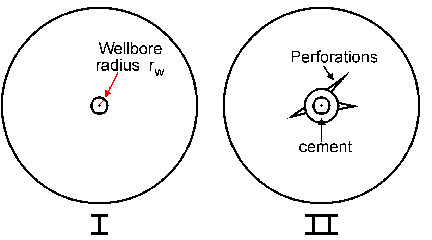Wellbore Radius (rw)
In pressure transient analysis, the wellbore is assumed to be cylindrical and has a specific radius called the wellbore radius as shown below:

This radius is used to determine the sandface area (2rwh), which represents the area through which all the produced reservoir fluids must flow. The sandface area has a significant effect on the flowing wellbore pressure, and thus, the wellbore radius is found in many of the flow equations used in Pressure Transient Analysis (PTA).
In real life, the area of contact between the wellbore and the formation is rarely cylindrical as seen above in Figure II. It depends on the perforations (density, phasing, effectiveness, etc.), and is also affected by the type of perforating gun, casing, cement, etc. Thus, a true wellbore radius does not exist (except for open hole completions), and the wellbore radius used in the PTA equations is an approximation at best. A reasonable value to use can be the drill bit radius, or the outside diameter of the casing. The default value used in the software is 0.3 ft (0.091 m).